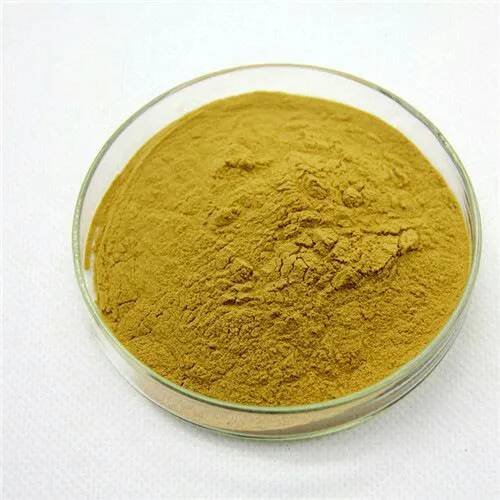- 0086-571-85302990
- sales@greenskybio.com
Echinacea Extract: China vs. the United States
2024-11-27

1. Introduction
Echinacea Extract has gained significant popularity in recent years due to its potential health benefits. This extract is derived from the Echinacea plant, which is native to North America. However, with the increasing global interest in herbal remedies, countries like China have also started to engage in the production and research of Echinacea Extract. This article aims to compare various aspects of Echinacea Extract in China and the United States, including origin, production, quality control, and applications.

2. Origin of Echinacea
2.1 In the United States
The Echinacea plant is native to the United States, particularly in the central and eastern regions. It has a long history of use by Native Americans for medicinal purposes. In the US, there are several species of Echinacea, such as Echinacea purpurea, Echinacea angustifolia, and Echinacea pallida, which are commonly used for extraction. These plants grow well in the prairies and open woodlands, with specific soil and climate requirements.
2.2 In China
Although Echinacea is not native to China, it has been introduced and cultivated in some regions. China has a large area suitable for cultivation due to its diverse climate zones. The cultivation of Echinacea in China is mainly for the purpose of extracting active ingredients to meet the domestic and international market demands. However, the origin of the seeds and plant varieties often trace back to the United States.

3. Production
3.1 Cultivation Methods
3.1.1 In the United States
In the US, Echinacea is often cultivated in large - scale farms. The cultivation process focuses on providing the plants with natural growing conditions similar to their native habitats. For example, Echinacea purpurea is typically grown in well - drained soil with sufficient sunlight. Organic farming methods are also becoming more popular, which avoid the use of synthetic pesticides and fertilizers. This helps to ensure the purity of the plants and the quality of the extract.
3.1.2 In China
China also adopts scientific cultivation methods. In some areas, modern agricultural techniques are used to improve the yield and quality of Echinacea. For instance, drip irrigation systems are used to precisely control the water supply, and greenhouses are used in some regions to regulate the temperature and humidity. Additionally, Chinese farmers may also use traditional Chinese agricultural knowledge to manage the growth of Echinacea, such as intercropping with other plants to improve soil fertility.
3.2 Extraction Techniques
3.2.1 In the United States
The United States has advanced extraction technologies for Echinacea extract. Commonly used methods include solvent extraction, where solvents such as ethanol are used to dissolve the active ingredients from the plant material. Supercritical fluid extraction is also being explored, which offers advantages in terms of purity and environmental friendliness. The extraction process is often carried out in specialized facilities with strict quality control measures to ensure the consistency and potency of the extract.
3.2.2 In China
In China, solvent extraction is also a widely used method for obtaining Echinacea extract. However, Chinese researchers are constantly exploring new extraction techniques to improve the quality and efficiency. For example, microwave - assisted extraction has been studied, which can reduce the extraction time and energy consumption. Chinese companies are also investing in advanced extraction equipment to meet the international quality standards.

4. Quality Control
4.1 In the United States
The US has a relatively strict regulatory framework for the quality control of Echinacea extract. The Food and Drug Administration (FDA) sets certain standards for the safety and efficacy of herbal products. For Echinacea extract, manufacturers are required to ensure the purity of the raw materials, the accuracy of the extraction process, and the stability of the final product. Quality control tests may include chemical analysis to determine the content of active ingredients, microbiological testing to check for contaminants, and stability testing to ensure the product's shelf - life.
4.2 In China
In China, the State Food and Drug Administration (SFDA) also has regulations in place for herbal extract products. Chinese standards focus on aspects such as pesticide residues, heavy metal content, and the quality of the active ingredients. Manufacturers are required to follow Good Manufacturing Practice (GMP) guidelines. Additionally, China is also actively participating in international standard - setting for herbal products to ensure the quality of its Echinacea extract can meet global requirements.

5. Applications
5.1 In the Medical Field
5.1.1 In the United States
In the US, Echinacea extract is often used as an herbal supplement to support the immune system. It is believed to help prevent and relieve the symptoms of colds and flu. Some studies have also suggested its potential anti - inflammatory and antioxidant properties, which may have implications for other health conditions. However, it should be noted that the FDA has not approved Echinacea extract as a drug for specific diseases, but rather as a dietary supplement.
5.1.2 In China
In China, Echinacea extract is also being studied for its potential health benefits. While traditional Chinese medicine has its own set of herbs for immune - boosting and disease prevention, Echinacea extract is gradually being incorporated into some health products. Chinese researchers are exploring its combination with other traditional Chinese herbs to develop new formulas for treating various health problems.
5.2 In the Cosmetic Industry
5.2.1 In the United States
In the US cosmetic industry, Echinacea extract is used in some skincare products. Its antioxidant properties are believed to help protect the skin from free radical damage, which can lead to premature aging. It may also have anti - inflammatory effects on the skin, making it suitable for products targeting sensitive or acne - prone skin.
5.2.2 In China
In China, the cosmetic market is growing rapidly, and Echinacea extract is starting to be used in some high - end skincare products. Chinese consumers are becoming more aware of the benefits of natural ingredients, and Echinacea extract is seen as a valuable addition to cosmetic formulations. However, the use of Echinacea extract in cosmetics in China also needs to comply with relevant regulations regarding safety and quality.
6. Differences in Regulatory Frameworks
The regulatory frameworks for Echinacea extract in the United States and China have some differences. In the US, as mentioned earlier, the FDA regulates herbal products mainly as dietary supplements. This means that while there are safety and quality requirements, the approval process is different from that of drugs. In China, the SFDA has a more comprehensive regulatory system for herbal products, which includes both traditional Chinese medicine and imported herbal extracts like Echinacea. The Chinese regulatory system places more emphasis on the integration of traditional knowledge and modern scientific methods in the evaluation of herbal products.
7. Conclusion
In conclusion, both China and the United States are involved in the production, research, and application of Echinacea extract. While there are differences in origin, cultivation methods, extraction techniques, quality control, and regulatory frameworks, there are also opportunities for cooperation and mutual learning. With the increasing global demand for herbal products, it is important for both countries to continue to improve the quality and safety of Echinacea extract, and to explore its potential in various fields through scientific research and international cooperation.
FAQ:
What are the main origins of Echinacea in China and the United States?
In the United States, Echinacea is native to certain regions and is widely cultivated in some areas. It is commonly found in the central and eastern parts of the United States. In China, some areas may also cultivate Echinacea, but it is not as native as in the United States. Some Echinacea plants in China may be introduced for cultivation mainly for the purpose of extraction and related product development.
How do the cultivation methods of Echinacea differ between China and the United States?
In the United States, due to its native environment, cultivation may often rely on natural climate conditions to a certain extent. The use of large - scale agricultural machinery is common in large - scale plantations. In China, cultivation may be more carefully managed in terms of soil quality improvement, pest control, and irrigation. Chinese cultivators may use some traditional agricultural techniques combined with modern scientific management methods. For example, in soil preparation, Chinese farmers may pay more attention to adding organic fertilizers to improve soil fertility for better growth of Echinacea plants.
What are the differences in extraction techniques of Echinacea extract between the two countries?
In the United States, extraction techniques may be more focused on large - scale and high - efficiency production. Advanced industrial extraction equipment is often used to ensure a relatively high yield in a short time. In China, while also aiming at efficient extraction, there may be more attention paid to the retention of active ingredients. Chinese extraction techniques may combine traditional Chinese medicine extraction concepts, such as using multi - step extraction methods to ensure that more valuable components in Echinacea are extracted while minimizing the loss of active ingredients.
How do the regulatory frameworks for Echinacea extract in China and the United States compare?
In the United States, the regulatory framework for Echinacea extract mainly focuses on safety and labeling requirements. The Food and Drug Administration (FDA) has certain regulations to ensure that products are safe for consumers and that the information on the label is accurate. In China, in addition to safety requirements, the regulatory system also takes into account the traditional Chinese medicine characteristics of Echinacea extract. There are regulations on quality standards, production processes, and the use of raw materials to ensure that the extract meets certain quality and efficacy requirements in line with Chinese medical concepts.
What are the main applications of Echinacea extract in China and the United States?
In the United States, Echinacea extract is often used in dietary supplements. It is promoted for its potential immune - boosting properties. In China, while also being considered for immune - enhancing effects, it may be further explored in combination with traditional Chinese medicine theories. For example, it may be studied for its role in regulating the body's overall balance in some health - promoting formulas.
Related literature
- Echinacea: A Review of Its Botany, Chemical Composition, Pharmacological Activity, and Clinical Applications"
- "Comparative Analysis of Echinacea Cultivation and Utilization in Different Regions"
- "Regulatory Aspects of Herbal Extracts: A Focus on Echinacea in the United States and China"
- ▶ Hesperidin
- ▶ citrus bioflavonoids
- ▶ plant extract
- ▶ lycopene
- ▶ Diosmin
- ▶ Grape seed extract
- ▶ Sea buckthorn Juice Powder
- ▶ Beetroot powder
- ▶ Hops Extract
- ▶ Artichoke Extract
- ▶ Reishi mushroom extract
- ▶ Astaxanthin
- ▶ Green Tea Extract
- ▶ Curcumin Extract
- ▶ Horse Chestnut Extract
- ▶ Other Problems
- ▶ Boswellia Serrata Extract
- ▶ Resveratrol Extract
- ▶ Marigold Extract
- ▶ Grape Leaf Extract
- ▶ blog3
- ▶ blog4
-
Extraction process of black pepper extract.
2024-11-27
-
Wholesale L - Tyrosine Suppliers.
2024-11-27
-
The best milk thistle extract in 2024.
2024-11-27
-
High - quality kidney bean extract products.
2024-11-27
-
The best aged garlic extract on the market.
2024-11-27
-
How to make powder with L - arginine.
2024-11-27
-
Withania Somnifera Extract
2024-11-27
-
Chaste Berry Extract
2024-11-27
-
Coix Seed Extract
2024-11-27
-
Andrographis Paniculata Extract Powder
2024-11-27
-
Passionflower Extract
2024-11-27
-
Quercetin
2024-11-27
-
Thunder God Vine Extract
2024-11-27
-
Beta Carotene
2024-11-27
-
Licorice Root Extract Powder
2024-11-27
-
Acerola Juice Powder
2024-11-27





















